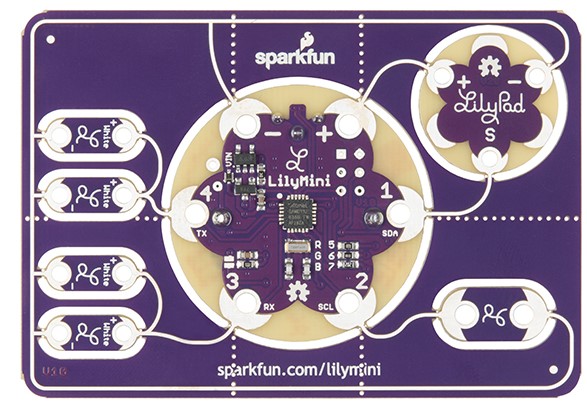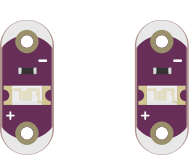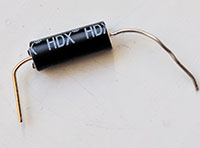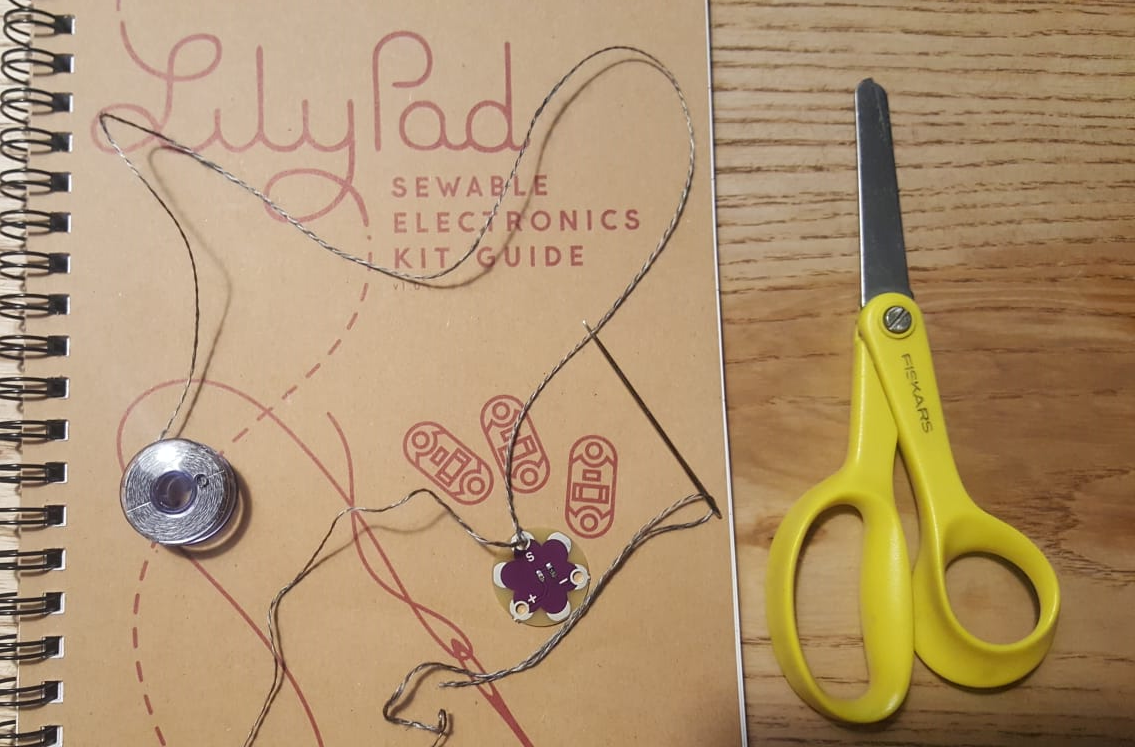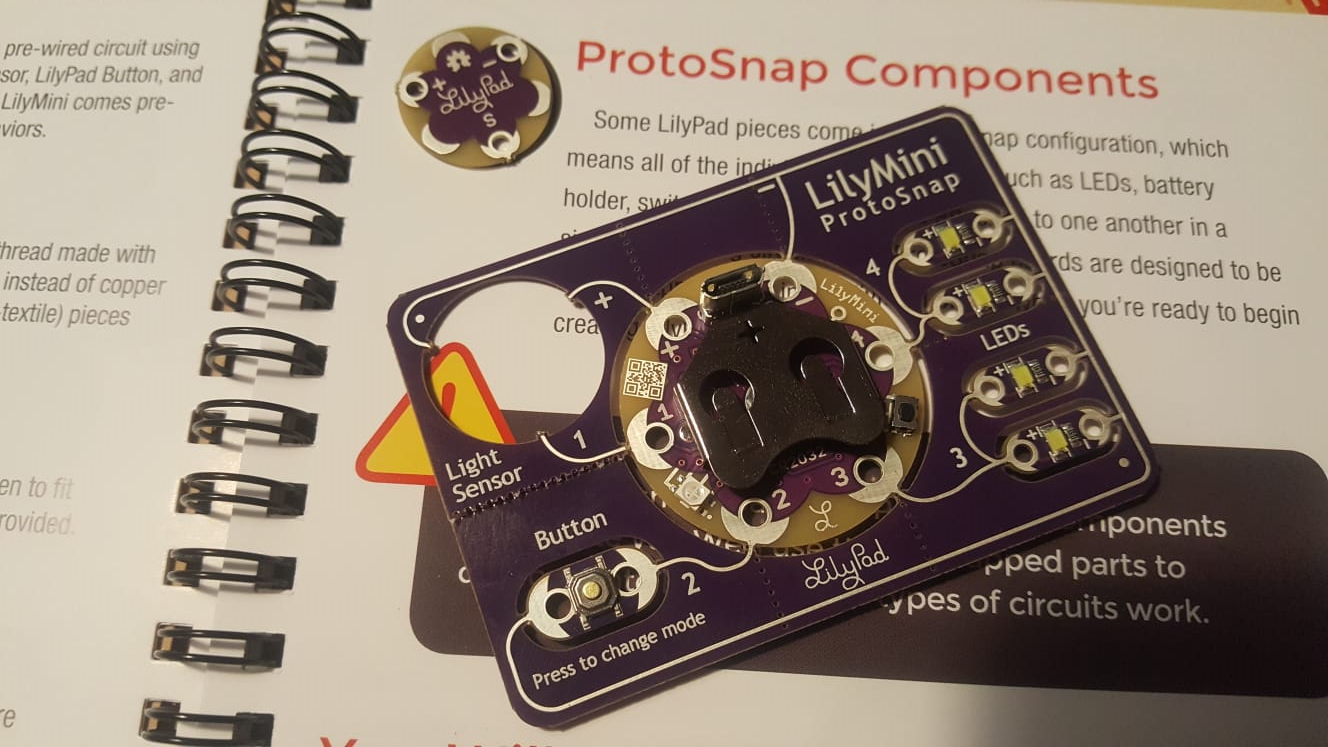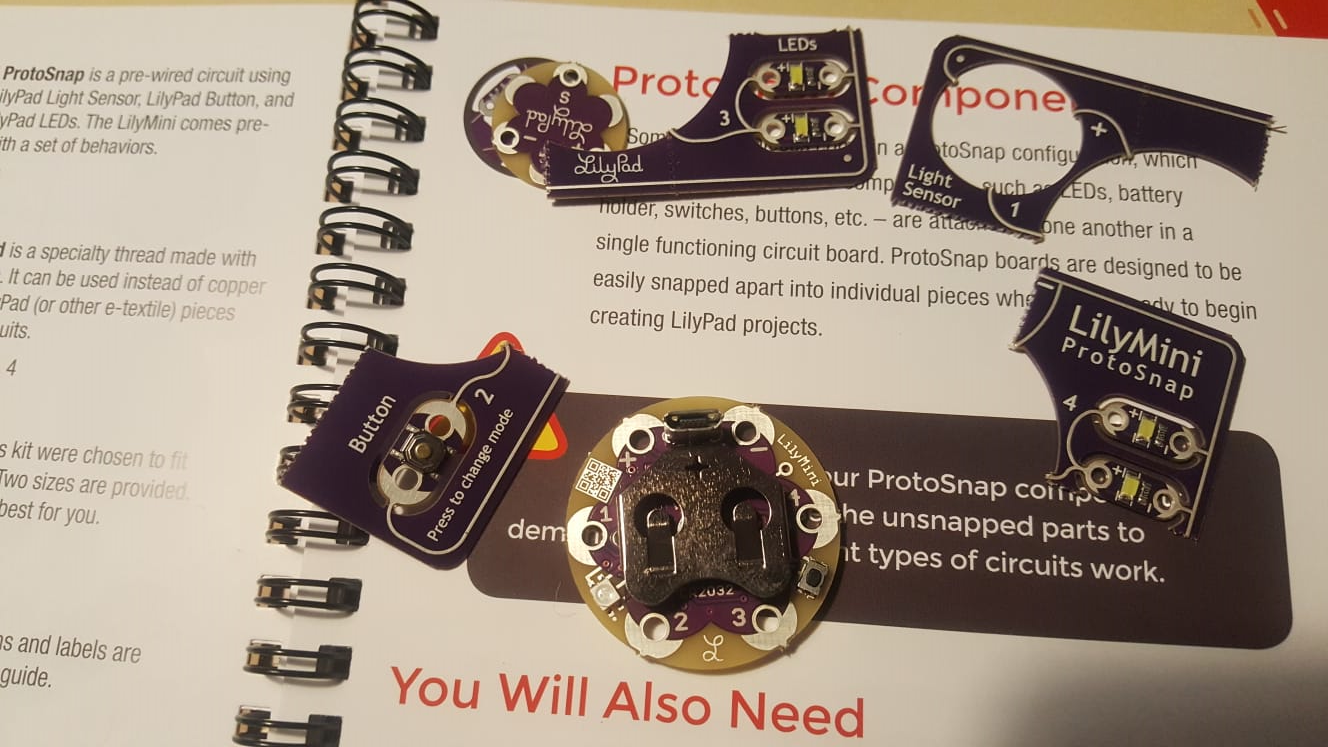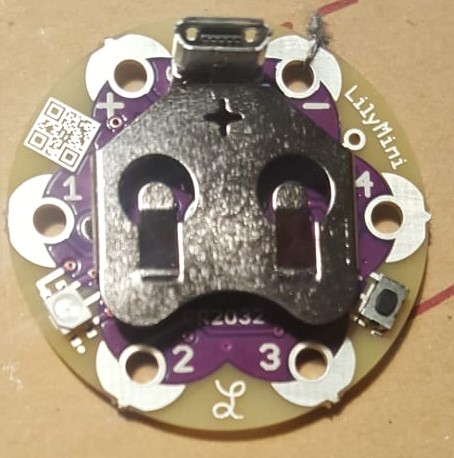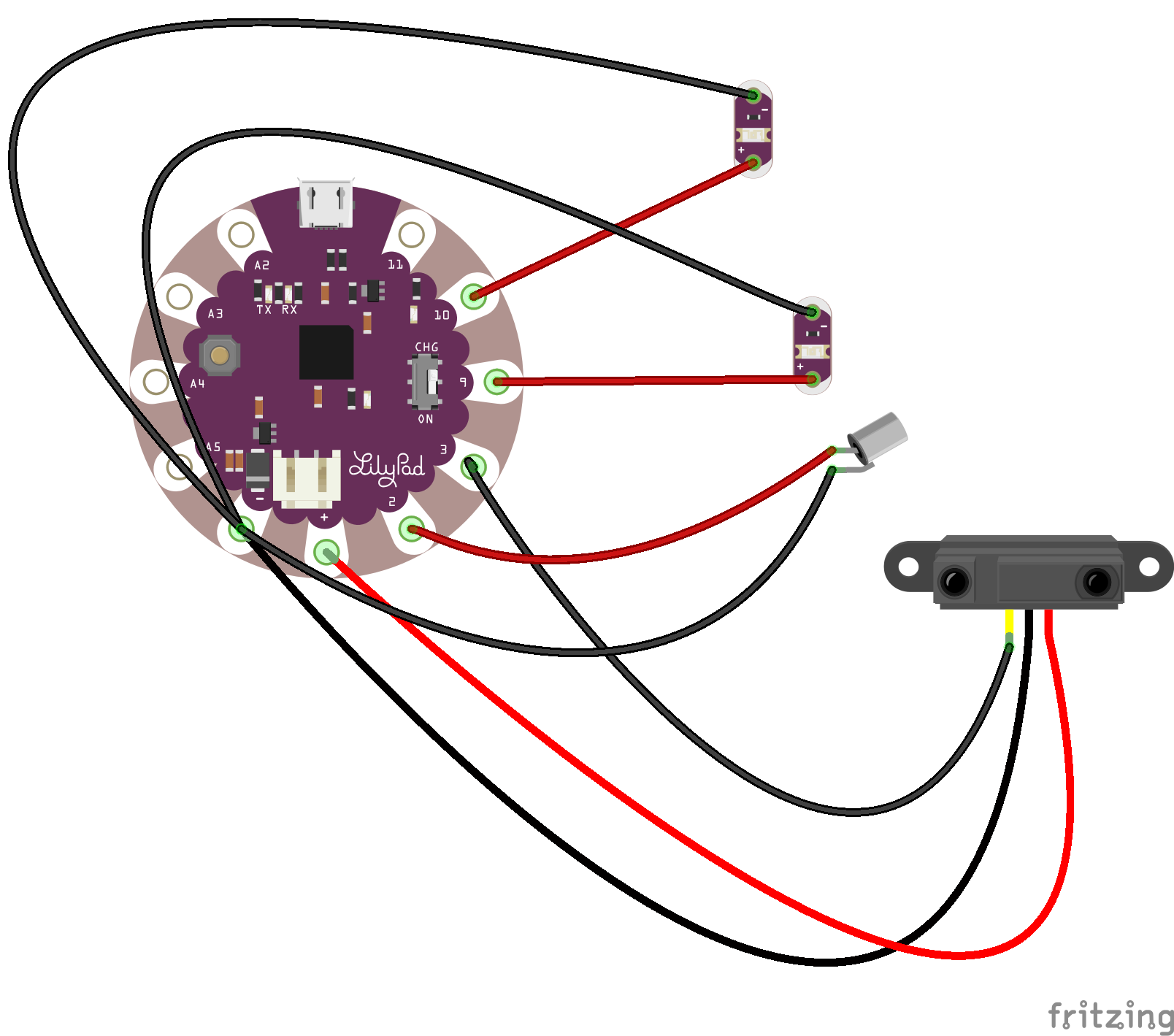Tekstitykset
okay this is the beginning the beginning of an epic project Atticus gonna count we already started making it Evie's gonna help me too we drew up art designs we ordered the parts got a bunch of lily patty textiles time to get started okay step one to make sewing easier you get a little frame for like cross stitching so we installed our battery make sure that we have power look at this sure enough just to test that we've got power running to be able to light up our LED so we got power that's first step now let's test to see if we can make it do a basic program okay we already hooked up power we figured out how to get the battery working we tried making the internal LED flash now we've done some basic stitching here we took our bank of LEDs and we stitched all the positives together we ran all the negatives to the ground and we've got a basic program running with all these from each port in the sweater that we make we're gonna have about five LEDs they're all going to be the same type so they'll have the same current drop across them these have slightly different voltages so they're drawing slightly different voltages or currents but it clearly is enough to show that this is going to work fine I was afraid it would be bright enough with the 40 milliamps that each port can put out but seems to not be a problem right now okay I've got the got the accelerometer stitched in now that's connected to the ground of the LED bank they've got power from the Tamiya battery and now we've got a simple program written where it's gonna monitor the Y component of the accelerometer in real time and as we lift it if we lift it above a certain threshold angle that we've programmed in it's gonna start to flash all right so I've got a tilt it up and that's the trigger for it to flash when I lower it down again it's off and it's running in real time all powered by the lithium battery right now okay check it out in the background we have pulsating we'll have a bunch of these all over the front of the sweater this will be like the stars of the galaxy all pulsing I'll have only white ones though and then when the arm gets raised up over a certain degree down the sleeve you'll have a bunch of things blasting they won't all be together they'll go in a row like doo-doo-doo but for now I've got them just wired together so we have a proof of concept it worked on this t-shirt with some crappy sewing so now we need a sweatshirt and we need to do some legit selling and it's gonna be sweet okay step 1 now that we got the co-working and we did a prototype we got a nice new sweater we're gonna have the Deathstar right here so we got some nice fabric for the Deathstar got a whole bunch of grays to look at we're kind of leaning towards this one because it's got this cool grid pattern by time you make a skull out of that put some black thread on it it's gonna look like a sweet death star [Music] okay we've got the sweater we've got a potential death star lay down there what we're gonna do is we're gonna take this off for right now we're just gonna make this thing sew it on we're gonna do all the contacts or make all these connections all right make all these connections first and then when all that's done there's gonna have a ton of wires coming off it we'll cover that up with this thing and we're just going to fuse that on okay so to these sleeves since we're gonna do a kind of complex pattern they're gonna be easier to so if we just unstitch it so use your handy dandy on stitcher tool they seem a ripper me rip those teams okay what we've decided to do first is we're gonna holster the battery down here so this we're gonna stitch a little pocket for it this thing that's it right like there which will allow us to wire into the positive and negative lines I've gone through and stitched in or I've drawn in red and black lines to represent where the positive and negative leads are going to go to power the accelerometer on either sleeve as well as the lines for the LEDs drew some patterns down and got an idea of where we want the thread to go we're putting down the negative lines first and the conductive thread is in the bobbin so it's showing up on the inside of the shirt and on the outside we've got a nice barek thread that you can't even see it's basically invisible up here so you can't just even see where you put it down now as you're sewing you're going to need to make sure that your positives and your negatives aren't getting crossed or you're going to short-circuit your thing so for example here we wanted this line to go through but I had to jump over another one so we put down some hot glue and some felt when I touch it over here I have contact right but that's not shorting over here it's still over one so I've got contact where I need it to be and I've got it short and I've got no contact right down here to me you need to test to make sure that these lines aren't shorting on one another in this case this line here was shorting with this line at this point so I made a cut here and I'm going to bypass it and come over and I'm going to reconnect it there to fix the short now that we have the wines running on the inside I decided would be easier if I went ahead and I hot-glued these into place with a hot glue gun so these are now in place I've got them on both sides running up and all the way down I need to do the same on that arm over here okay now that we've we want to do you want to test to see if it has connectivity I'm going to take this I'm going to hold it in the pin number one right there I'm gonna test it against I'm gonna test to see if it's connecting so right here it should be not connecting and sure enough the dial is still at overload same over here say however on this one where it should be connecting it's reading a value over here it's not nothing nothing nothing nothing you okay the copper wire is not the worst thing ever it works you can send it down there and sort of bundle as you go it's not ideal but it'll work okay it's actually kind of nice to solder onto things that holds pretty well I made one big common wire here so that I can put all my grounded wires to you okay with the arms done all right these need to be sewed in still but the arms are both done now we can turn our attention to the middle right so I hot-glued a bunch of these things down and I've got them twinkling in and out of phase with one another so the Sun go down mothers go bright I need to finish these ones right I'm using the pwm pins over here so this is pin number 10 nine six and five those are the four PW pins that I'm using for this and by tomorrow night this thing should be done okay so in its current form it's working we've got four different sets of lights on the front which like the stars twinkling I still need to put the Death Star on here and if I raise my arm I get these things to pulse two of the bed bands of LED still neither so dog you know we're here for the same thing also go to need to be connected still these ones need to be connected to the ports you can't do that while you're loading the program onto it yep both up they both go one after another they both down and normal neither one goes and these things go back to complain the final touches on the sweater was to add the Deathstar which I drew on this fabric that sort of had a grid-like pattern to it I made sure to leave the opening for the blaster to be where there are three no sets and now it looked kind of like it's blasting lasers when you lift this arm up which is pretty darn sweet you okay after making all the correction final product the middle has twinkles you've got the death star with a lily pad in the middle I fixed everything it's a bit wrinkled up because the tape inside and when you grab these not even enough lift those up synchronised they both now light up in a synchronized manner until you let them down okay about that they caught us and you let them down they stop thanks Bob
